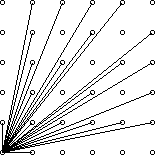[数论] POJ 3090/HOJ 2416 Visible Lattice Points 欧拉函数
2014-02-10 13:03
507 查看
传送门:Visible Lattice Points
Visible Lattice Points
Description
A lattice point (x, y) in the first quadrant (x and y are integers greater than or equal to 0), other than the origin, is visible from the origin if the
line from (0, 0) to (x, y) does not pass through any other lattice point. For example, the point (4, 2) is not visible since the line from the origin passes through (2, 1). The figure below shows the points
(x, y) with 0 ≤ x, y ≤ 5 with lines from the origin to the visible points.

Write a program which, given a value for the size, N, computes the number of visible points (x, y) with 0 ≤ x, y ≤ N.
Input
The first line of input contains a single integer C (1 ≤ C ≤ 1000) which is the number of datasets that follow.
Each dataset consists of a single line of input containing a single integer N (1 ≤ N ≤ 1000), which is the size.
Output
For each dataset, there is to be one line of output consisting of: the dataset number starting at 1, a single space, the size, a single space and the number of visible points for that size.
Sample Input
Sample Output
Source
Greater New York 2006
解题报告:
先画一条(0, 0)到(n, n)的线,把图分成两部分,两部分是对称的,只需算一部分就好。
取右下半,这一半里的点(x, y)满足x >= y
可以通过欧拉函数计算第k列有多少点能够连到(0, 0)
若x与k的最大公约数d > 1,则(0, 0)与(x, k)点的连线必定会通过(x/d, k/d),就被挡住了
所以能连的线的数目就是比k小的、和k互质的数的个数,然后就是欧拉函数。
代码如下:
#include<stdio.h>
int eular(int n){
int ret=1,i;
for(i=2;i*i<=n;i++)
if (n%i==0){
n/=i,ret*=i-1;
while (n%i==0)
n/=i,ret*=i;
}
if (n>1)
ret*=n-1;
return ret; //n的欧拉数
}
int main(){
int test;
int n;
int i;
int ans;
int t=0;
scanf("%d",&test);
while(test--){
ans=0;
scanf("%d",&n);
for(i=2;i<=n;i++)
ans+=eular(i);
printf("%d %d %d\n",++t,n,ans*2+3);
}
return 0;
}
Visible Lattice Points
| Time Limit: 1000MS | Memory Limit: 65536K | |
| Total Submissions: 5126 | Accepted: 2978 |
A lattice point (x, y) in the first quadrant (x and y are integers greater than or equal to 0), other than the origin, is visible from the origin if the
line from (0, 0) to (x, y) does not pass through any other lattice point. For example, the point (4, 2) is not visible since the line from the origin passes through (2, 1). The figure below shows the points
(x, y) with 0 ≤ x, y ≤ 5 with lines from the origin to the visible points.

Write a program which, given a value for the size, N, computes the number of visible points (x, y) with 0 ≤ x, y ≤ N.
Input
The first line of input contains a single integer C (1 ≤ C ≤ 1000) which is the number of datasets that follow.
Each dataset consists of a single line of input containing a single integer N (1 ≤ N ≤ 1000), which is the size.
Output
For each dataset, there is to be one line of output consisting of: the dataset number starting at 1, a single space, the size, a single space and the number of visible points for that size.
Sample Input
4 2 4 5 231
Sample Output
1 2 5 2 4 13 3 5 21 4 231 32549
Source
Greater New York 2006
解题报告:
先画一条(0, 0)到(n, n)的线,把图分成两部分,两部分是对称的,只需算一部分就好。
取右下半,这一半里的点(x, y)满足x >= y
可以通过欧拉函数计算第k列有多少点能够连到(0, 0)
若x与k的最大公约数d > 1,则(0, 0)与(x, k)点的连线必定会通过(x/d, k/d),就被挡住了
所以能连的线的数目就是比k小的、和k互质的数的个数,然后就是欧拉函数。
代码如下:
#include<stdio.h>
int eular(int n){
int ret=1,i;
for(i=2;i*i<=n;i++)
if (n%i==0){
n/=i,ret*=i-1;
while (n%i==0)
n/=i,ret*=i;
}
if (n>1)
ret*=n-1;
return ret; //n的欧拉数
}
int main(){
int test;
int n;
int i;
int ans;
int t=0;
scanf("%d",&test);
while(test--){
ans=0;
scanf("%d",&n);
for(i=2;i<=n;i++)
ans+=eular(i);
printf("%d %d %d\n",++t,n,ans*2+3);
}
return 0;
}
相关文章推荐
- 1.m分解阶乘之和
- 2.几种递推数
- 3.欧拉函数
- 4.快速幂模m算法
- 5.扩展欧几里得&&中国剩余定理
- 6.数论_web
- 欧拉函数
- 组合数求模总结
- 整数对
- Leftmost Digit
- POJ 3292.Semi-prime H-numbers
- HDU 1133 (数论 or DP、高精度;Java版)
- POJ 1061 青蛙的约会
- zoj_3621 Factorial Problem in Base K
- zoj_1657 Goldbach's Conjecture
- zoj_1526 Big Number
- poj_3210 Coins
- poj_1528 Perfection
- poj_2262 Goldbach's Conjecture
- poj_2992 Divisors
